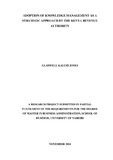| dc.description.abstract | Knowledge management as an organizational concept has grown to be a discipline worth discernment with principles, practices and tools that make it unique. As a discourse, it has given rise to innovations and structures that enable us understand how organizations utilize knowledge to create value. Kimiz Dalkir (2005) presents a thoughtful, systematic view of knowledge management as a coherent body of management theory and practice. He argues that though there is no single, universal recipe for managing knowledge, we have to accept that it provides a framework for designing an organization‘s goals, structures, and processes so that the organization can use what it knows to learn and to create value for its customers and community. This demands that each organization has to think through and design its own approach. Hovland (2003) confirms this when he maps out the rationale and objectives of knowledge management and learning within organizations as he magnifies specific characteristics and challenges of different types of organizations in the development field in light of their knowledge needs. Due to the vast amount of studies already done on these issues plaguing knowledge management in organizations, this study presents yet another guideline on ‗how to do KM‘ but put into perspective the deployment of tools and manuals of knowledge management that will enable the Kenya Revenue Authority make the leap in not only efficiency, but improved responsiveness, partnership, and policy influence. The need for this study was justified by the fact that there has to exist a design process which provides a set of organizational enablers posed by the questions: What is the organizational vision or strategy driving the need to manage knowledge? What roles and structures ought to be in place? How to develop processes and practices that promote knowledge sharing and use? Which tools and platforms can support these efforts? | en_US |

